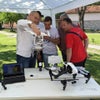Hochosterwitz Castle (also known as Burg Hochosterwitz) is considered to be one of Austria's most impressive medieval castles. It is situated on a 160 m (525 ft) Dolomite rock near Sankt Georgen am Längsee, east of the town of Sankt Veit an der Glan in Carinthia. The castle can be seen from about 30 km (20 miles) away on a clear day.
The site was first mentioned in a 860 deed of King Louis the German, where it was called Astarwiza (its name being of Slovenian origin). In the 11th century the castle had been a fiefdom granted by the Archbishop Gebhard of Salzburg to the Spanheim noble family in return for their support during the Investiture Controversy. The Counts of Spanheim, meanwhile Dukes of Carinthia, bestowed upon the family of Osterwitz the hereditary office of the cup-bearer in 1209. In the 15th century, the last cup-bearer of Osterwitz was captured in a Turkish invasion and died in prison without leaving descendants. Possession of the castle then reverted to Emperor Frederick III.
In his book Change the Austro-American psychologist Paul Watzlawick renders a popular tale of the siege of the castle by Margarete Maultasch ("Mouth Bag"), countess of Tyrol (1318-1369). According to legend, first noted by the medieval chronicler Jakob Unrest and later by Jacob Grimm, Margarete's forces were deceived and withdrew when the garrison of the castle slaughtered its very last ox, filled it with corn and threw it over the wall, pretending it still has got plenty of food in stock. The scene is also described in the book Die hässliche Herzogin (The Ugly Duchess) by Lion Feuchtwanger.
About 1541 Emperor Ferdinand I bestowed Hochosterwitz upon governor Christof Khevenhüller. In 1571, Baron George Khevenhüller acquired the citadel by purchase. He fortified to deal with the threat of Turkish invasions of the region, building an armoury and 14 gates from 1570-1586. Such massive fortification is considered unique in citadel construction. Because of the 14 gates, each equipped with different treacherous methods of guarding the path, local legend maintains that the castle has never been conquered.
Since the 16th century, no major changes have been made to Hochosterwitz. It has also remained in the possession of the Khevenhüller family as requested by the original builder, George Khevenhüller. A marble plaque dating from 1576 in the castle yard documents this request.
Some parts of the castle are open to the public every year from Easter to the end of October. Tourists are allowed to walk the 620 meter long pathway through the 14 gates up to the castle; each gate has a diagram of the defense mechanism used to seal that particular gate.
Hochosterwitz Castle can be reached by car or an easy hike from the Sankt Veit an der Glan train station, with connection to nearby Klagenfurt.
A 1:25 miniature scale model of Hochosterwitz Castle may be seen at Minimundus, a popular tourist attraction in Klagenfurt that is approximately 20 km away from the castle.





